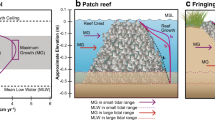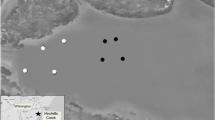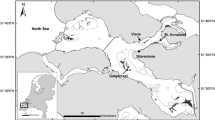Abstract
Oyster populations within the coastal bays of Virginia have greatly declined, mainly due to overharvesting and disease, and past restoration efforts have largely focused on increasing their populations. Current restoration goals have now expanded to simultaneously procure the wider ecosystem services oysters can offer, including shoreline protection and ecosystem diversification. However, tradeoffs exist in designing artificial reefs because it is unlikely one design will optimize all services. This study compares the services provided by reef designs varying in elevation and width located adjacent to an intertidal marsh within a coastal bay of VA, USA. We quantified wave attenuation to determine potential coastal protection of the adjacent marsh, and changes to sediment composition and infaunal communities before and after reef construction for 3 years. After construction, we also quantified oyster size and population density to compare high and low elevation reef designs. High elevation reefs were more effective at attenuating waves and fostering oyster growth compared to low elevation reefs. Oysters atop high elevation reefs were on average approximately twice as dense and 20% larger than those on low elevation designs. Reef width had a minimal effect on oyster population density; densities on high and low reefs were similar for designs with one or three rows. The presence of oyster reefs also increased infaunal diversity and sediment organic matter. Our results indicate that artificial reef design can differentially affect the services provided through restoration, and elevation is especially important to consider when designing for oyster population enhancement and coastal protection.







Similar content being viewed by others
References
Bartol, I.K., R. Mann, and M. Luckenbach. 1999. Growth and mortality of oysters (Crassostrea virginica) on constructed intertidal reefs: Effects of tidal height and substrate level. Journal of Experimental Marine Biology and Ecology 237: 157–184.
Bilkovic, D.M., and M.M. Mitchell. 2013. Ecological tradeoffs of stabilized salt marshes as a shoreline protection strategy: Effects of artificial structures on microbenthic assemblages. Ecological Engineering 61: 469–481.
Borsje, B.W., B.K. van Wesenbeeck, F. Dekker, P. Paalvast, T.J. Bouma, M.M. van Katwijk, and M.B. De Vries. 2010. How ecological engineering can serve in coastal protection. Ecological Engineering 37: 113–122.
Bulleri, F., and M.G. Chapman. 2010. The introduction of coastal infrastructure as a driver of change in marine environments. Journal of Applied Ecology 47: 26–35.
Byers, J.E., J.H. Grabowski, M.F. Piehler, A.R. Hughes, H.W. Weiskel, J.C. Malek, and D.L. Kimbro. 2015. Geographic variation in intertidal oyster reef properties and the influence of tidal prism. Limnology and Oceanography 60: 1051–1063.
Castel, J., P.J. Labourg, V. Escaravage, I. Auby, and M.E. Garcia. 1989. Influence of seagrass beds and oyster parks on the abundance and biomass patterns of meio- and macrobenthos in tidal flats. Estuarine Coastal and Shelf Science 28: 71–85.
Coen, L.D., and M.W. Luckenbach. 2000. Developing success criteria and goals for evaluating oyster reef restoration: Ecological function or resource exploitation? Ecological Engineering 15: 323–343.
Coen, L.D., R.D. Brumbaugh, D. Bushek, R. Grizzle, M.W. Luckenbach, M.H. Posey, S.P. Powers, and G. Tolley. 2007. Ecosystem services related to oyster restoration. Marine Ecology Progress Series 341: 303–307.
Davis J.L.D., R.L. Takacs, and R. Schnabel. 2006. Evaluating ecological impacts of living shorelines and shoreline habitat elements: an example from the upper western Chesapeake Bay, p. 55–61. In Management, policy, science, and engineering of nonstructural erosional control in the Chesapeake Bay, CRC Publ. No. 08 – 164, Chesapeake Bay, eds. S.Y. Erdle, J.L.D Davis, K.G. Sellner.
Dernie, K.M., M.J. KaiserJ, and R.M. Warwick. 2003. Recovery rates of benthic communities following physical disturbance. Journal of Animal Ecology 72: 1043–1056.
Donadi, S., J. Westra, E.J. Weerman, T. Van der Heide, E.M. Van der Zee, J. Van de Koppel, H. Olff, T. Piersma, H.W. Van der Veer, and B.K. Eriksson. 2013. Nontrophic interactions control benthic producers on intertidal flats. Ecosystems 16: 1325–1335.
Ehrenfeld, J.G. 2000. Defining the limits of restoration: The need for realistic goals. Restoration Ecology 8: 2–9.
Fagherazzi, S., and P.L. Wiberg. 2009. Importance of wind conditions, fetch, and water levels on wave-generated shear stresses in shallow intertidal basins. Journal of Geophyscial Research 114: F03022. https://doi.org/10.1029/2008JF001139.
Fodrie, F.J., A.B. Rodriguez, C.J. Baillie, M.C. Brodeur, S.E. Coleman, R.K. Gittman, D.A. Keller, M.D. Kenworthy, A.K. Poray, J.T. Ridge, E.J. Theurkauf, and N.L. Lindquist. 2014. Classic paradigms in a novel environment: Inserting food web and productivity lessons from rocky shores and saltmarshes into biogenic reef restoration. Journal of Applied Ecology 51: 1314–1325.
Fox, J. and S. Weisberg. 2019. An {R} companion to applied regression. Third editions. Thousand Oaks CA https://socialsciences.mcmaster.ca/jfox/Books/Companion/.
Fuchs, H.L., and M.A. Reidenbach. 2013. Biophysical constraints on optimal patch lengths for settlement of a reef-building bivalve. PLoS ONE 8: e71506.
Fulford, R.S., D.L. Breitburg, M. Luckenbach, and R.I.E. Newell. 2010. Evaluating ecosystem response to oyster restoration and nutrient load reduction with a multispecies bioenergetics model. Ecological Applications 20: 915–934.
Grabowski, J.H., A.R. Hughes, D.L. Kimbro, and M.A. Dolan. 2005. How habitat setting influences restored oyster reef communities. Ecology 86: 1926–1935.
Grabowski, J.H., and Peterson CH. 2007. Restoring oyster reefs to recover ecosystem services. In Ecosystem engineers: concepts, theory and applications, eds. K. Cuddington, J.E. Byers JE, W.G. Wilson, and A. Hastings, 281–298. Amsterdam: Elsevier-Academics Press.
Grabowski, J.H., R.D. Brumbaugh, R.F. Conrad, A.G. Keeler, J.J. Opaluch, C.H. Peterson, M.F. Piehler, S.P. Powers, and A.R. Smyth. 2012. Economic valuation of ecosystem services provided by oyster reefs. BioScience 621: 900–909.
Gregalis, K.C., M.W. Johnson, and S.P. Powers. 2009. Restored oyster reef location and design affect responses of resident and transient fish, crab, and shellfish species in Mobile Bay, Alabama. Transactions of the American Fisheries Society 138: 314–327.
Gorska, B., S. Gromisz, and M. Wlodarska-Kowalczuk. 2019. Size assessment in polychaete worms – application of morphometric correlations for common North Atlantic taxa. Limnology and Oceanography: Methods 17: 254–265.
Gosselin, L.A., and P. Qian. 1997. Juvenile mortality in benthic marine invertebrates. Marine Ecology Progress Series 146: 265–282.
Gutierrez, J.L., C.G. Jones, D.L. Strayer, and O.O. Iribarne. 2003. Mollusks as ecosystem engineers: The role of shell production in aquatic habitats. Oikos 101: 79–90.
Hansen, J.C., and M.A. Reidenbach. 2013. Seasonal growth and senescence of a Zostera marina seagrass meadow alters wave-dominated flow and sediment suspension within a coastal bay. Estuaries and Coasts 36: 1099–1114.
Harwell, H.D., M.H. Posey, and T.D. Alphic. 2011. Landscape aspects of oyster reefs: Effects of fragmentation on habitat utilization. Journal of Experimental Marine Biology and Ecology 409: 30–41.
Hill, J.M., and M.J. Weissburg. 2013. Habitat complexity and predator size mediate interactions between intraguild blue crab predators and mud crab prey in oyster reefs. Marine Ecology Progress Series 488: 209–219.
Hogan, S., and M.A. Reidenbach. 2019. Quantifying and mapping intertidal oyster reefs utilizing LiDAR-based remote sensing. Marine Ecology Progress Series 630: 83–99.
Howmiller, R.P. 1972. Effects of preservatives on weights of some common microbenthic invertebrates. Transactions of the American Fisheries Society 4: 743–746.
Hubbard, A.B., and M.A. Reidenbach. 2015. Effects of larval swimming behavior on the dispersal and settlement of the eastern oyster Crassostrea virginica. Marine Ecology Progress Series 535: 161–176.
Johnson, K.D., and D. Smee. 2014. Predators influence the tidal distribution of oyster (Crassostrea virginica). Marine Biology 161: 1557–1564.
Kemp, W.M., W.R. Boynton, J.E. Adolf, D.F. Boesch, W.C. Boicourt, G. Brush, J.C. Cornwell, T.R. Fisher, P.M. Glibert, J.D. Hagy, L.W. Harding, E.D. Houde, D.G. Kimmel, W.D. Miller, R.I.E. Newell, M.R. Roman, E.M. Smith, and J.C. Stevenson. 2005. Eutrophication of Chesapeake Bay: Historical trends and ecological interactions. Marine Ecology Progress Series 303: 1–29.
La Peyre, M.K., A.T. Humphries, S.M. Casas, and J.F.L. Peyre. 2014. Temporal variation in development of ecosystem services from oyster reef restoration. Ecological Engineering 64: 34–44.
Langlois, T.J., M.J. Anderson, and R.C. Babcock. 2006. Inconsistent effects of reefs on different size classes of macrofauna in adjacent sand habitats. Journal of Experimental Marine Biology and Ecology 334: 269–282.
Lenihan, H.S. 1999. Physical-biological coupling on oyster reefs: How habitat structure influences individual performance. Ecological Monographs 69: 251–275.
Length, R.V. 2020. emmeans: estimated marginal means,aka least-squares means. R package version 1.5.3. https://CRAN.R-project.org/package=emmeans.
Liu, Z.Q., P. Yu, M. Chen, M. Cai, B. Fan, W. Lv, H. Youhui, Y. Li, and Y. Zhao. 2018. Macrobenthic community characteristics and ecological health of a constructed intertidal oyster reef in the Yangtze Estuary, China. Marine Pollution Bulletin 135: 95–104. https://doi.org/10.1016/j.marpolbul.2018.07.019.
Mann, R., and E.N. Powell. 2007. Why oyster restoration goals in the Chesapeake Bay are not and probably cannot be achieved. Journal of Shellfish Research 26: 905–917.
Mariotti, G., and S. Fagherazzi. 2013. Critical width of tidal flats triggers marsh collapse in the absence of sea-level rise. Proceedings of the National Academy of Sciences of the United States of America 110: 5353–5336.
Meyer, D.L., E.C. Townsend, and G.W. Thayer. 1997. Stabilization and erosion control value of oyster cultch for intertidal marsh. Restoration Ecology 5: 93–99.
Millennium ecosystem assessment (MEA) Ecosystems and human well-being: synthesis. 2005. Washington DC: Island Press.
Murphy, E.A.K., and M.P. Volaric. 2021. Benthic invertebrates from intertidal mudflats at the on the coast of Virginia, 2016 ver 1. Environmental Data Initiative. https://doi.org/10.6073/pasta/7deadc96ff337c3a30a82df0bb39ae3b. (Accessed 2021-08-31)
Nelson, E., G. Mendoza, J. Regetz, S. Polasky, H. Tallis, D.R. Cameron, K.M.A. Chan, G.C. Daily, J. Goldstein, P.M. Kareiva, E. Lonsdorf, R. Naidoo, T.H. Ricketts, and M.R. Shaw. 2009. Modeling multiple ecosystem services, biodiversity conservation, and tradeoffs at landscape scales. Frontiers in Ecology and the Environment 7: 4–11.
North, E.W., D.M. King, J. Xu, R.R. Hood, R.I.E. Newell, K. Paynter, M.L. Kellog, M.K. Liddel, and D.F. Boesch. 2010. Linking optimization and ecological models in a decision support tool for oyster restoration and management. Ecological Applications 23:851–866. https://doi.org/10.1890/08-1733.1
O’Beirn, F.X., M. Luckenbach, R.L. Mann, J. Harding, and J. Nestlerode. 1999. Ecological functions of constructed oyster reefs along an environmental gradient in Chesapeake Bay. Final Report, Aquatic Reef Habitat Program, Chesapeake Bay Program, Annapolis, MD.
O’Beirn, F.X., M. Luckenbach, J.A. Nestlerode, and G.M. Coates. 2000. Toward designing criteria in constructed oyster reefs: Oyster recruitment as a function of substrate type and tidal height. Journal of Shellfish Research 19: 387–395.
Piazza, B.P., P.D. Banks, M.K. Peyre, and M.K. La. 2005. The potential for created oyster shell reefs as a sustainable shoreline protection strategy in Louisiana. Restoration Ecology 13: 499–506.
Reidenbach M.A., P. Berg, A. Hume, J.C. Hansen, and E.R. Whitman. 2013. Hydrodynamics of intertidal oyster reefs: The influence of boundary layer flow processes on sediment and oxygen exchange. Limnology & Oceanography: Fluids & Environments 3: 225–239.
Rodney W.S., and K.T. Paynter. 2006. Comparisons of macrofaunal assemblages on restored and non-restored oyster reefs in mesohaline regions of the Chesapeake Bay in Maryland. Journal of Experimental Marine Biology and Ecology 335: 39–51.
Rumohr, H. 2009. Soft-bottom macrofauna: collection, treatment, and quality assurance of samples. ICES Techniques in marine environmental. Science 43. https://doi.org/10.25607/OBP-238
Rothschild, B.J., J.S. Ault, P. Goulletquer, W.P. Jensen, and M. Heral. 1994. Decline of the Chesapeake Bay oyster population: A century of habitat destruction and overfishing. Marine Ecology Progress Series 111: 29–39.
Safak, I., P.L. Wiberg, D.L. Richardson, and M.O. Kurum. 2015. Controls on residence time and exchange in a system of shallow coastal bays. Continental Shelf Research 97: 7–20.
Schulte, D.M., R.P. Burke, and R.N. Lipcius. 2009. Unprecedented restoration of a native oyster metapopulation. Science 325: 1124–1128.
Smaal, A.C., and T.C. Prins. 1993. The uptake of organic matter and release of inorganic nutrients by bivalve suspension feeder beds. In Bivalve filter feeders in estuarine and coastal ecosystem processes, ed. R.F. Dame, 271–298. Berlin: Springer-Verlag.
Smyth, A.R., N.R. Geraldi, S.P. Thompson, and M.F. Piehler. 2016. Biological activity exceeds biogenic structure in influencing sediment nitrogen cycling in experimental oyster reefs. Marine Ecology Progress Series 560: 173–183. https://doi.org/10.3354/meps11922.
Soniat, T.M., C.M. Finelli, and J.T. Ruiz. 2004. Vertical structure and predator refuge mediate oyster reef development and community dynamics. Journal of Experimental Marine Biology and Ecology 310: 163–182.
Southwell, M.W., J.J. Veenstra, C.D. Adams, E.V. Scarlett, and K.B. Payne. 2017. Changes in sediment characteristics upon oyster reef restoration, NE Florida, USA. Journal of Coastal Zone Management 20: 442. https://doi.org/10.4172/2473-3350.1000442.
Southworth, M., J.M. Harding, J.A. Wesson, and R. Mann. 2010. Oyster (Crassostrea virginica, Gmelin 1791) population dynamics on public reefs in the Great Wicomico River, Virginia, USA. Journal of Shellfish Research 29: 271–290.
Theuerkauf, S.J., R.P. Burke, and R.N. Lipcius. 2015. Settlement, growth, and survival of eastern oysters on alternative reef substrates. Journal of Shellfish Research 34: 241–250.
Thomsen, M.S., and K. McGlathery. 2006. Effects of accumulations of sediments and drift algae on recruitment of sessile organisms associated with oyster reefs. Journal of Experimental Marine Biology and Ecology 328: 22–34.
Van der Zee, E.M., T. Van der Heide, S. Donadi, J.S. Eklof, B.K. Eriksson, H. Olff, H.W. Van der Veer, and T. Piersma. 2012. Spatially extended habitat modification by intertidal reef-building bivalves has implications for consumer-resource interactions. Ecosystems 15: 664–673.
Van der Zee, E.M., E. Tielens, S. Holthuijsen, S. Donadi, B.K. Eriksson, H.W. Van der Veer, T. Piersma, H. Olff, and T. Van der Heide. 2015. Habitat modification drives benthic trophic diversity in an intertidal soft-bottom ecosystem. Journal of Experimental Marine Biology and Ecology 465: 41–48.
Venables, W.N., and B.D. Ripley. 2002. Modern Applied Statistics with S, 4th ed. New York: Springer.
Volaric, M.P., P. Berg, and M.A. Reidenbach. 2018. Oxygen metabolism of intertidal oyster reefs measured by aquatic eddy covariance. Marine Ecology Progress Series 599: 75–91.
Volaric, M.P., P. Berg, and M.A. Reidenbach. 2019. An invasive macroalga alters ecosystem metabolism and hydrodynamics on a tidal flat. Marine Ecology Progress Series 628: 1–16.
Volaric, M.P., P. Berg, and M.A. Reidenbach. 2020. Drivers of oyster reef ecosystem metabolism measured across multiple timescales. Estuaries and Coasts 1–12.
Wetzel, M.A., H. Leuchs, and J.H.E. Koop. 2005. Preservation effects on wet weight, dry weight, and ash-free dry weight biomass estimates of four common estuarine macro-invertebrates: No difference between ethanol and formalin. Helgoland Marine Research 59: 206–213.
Whitman, E.R., and M.A. Reidenbach. 2012. Benthic flow environments affect recruitment of Crassostrea virginica larvae to an intertidal oyster reef. Marine Ecology Progress Series 463: 177–191.
Wiberg, P., S.R. Taube, A.E. Ferguson, M.R. Kremer, and M.A. Reidenbach. 2019. Wave attenuation by oyster reefs in shallow coastal bays. Estuaries and Coasts 42: 331–347. https://doi.org/10.1007/s12237-018-0463-y.
Zhang, S., Y. Liu, and H. Yang. 2014. Biologically induced deposition of fine suspended particles by filter-feeding bivalves in land-based industrial marine aquaculture wastewater. PLoS ONE 9(9): e107798. https://doi.org/10.1371/journal.pone.0107798.
Ziegler, S.L., J.H. Grabowski, C.J. Baillie, and F.J. Fodrie. 2017. Effects of landscape setting on oyster reef structure and function largely persist more than a decade post-restoration. Restoration Ecology 26: 933–942.
Zuur, A.F., E.N. Ieno, N.J. Walker, A.A. Saveliev, and G.M. Smith. 2009. Mixed effects models and extensions in ecology with R. In Statistics for Biology and Health, eds. Gail, M., K. Krickeberg, J.M. Samet, A. Tsiatis, and W. Wong. New York: Springer Science & Business Media.
Acknowledgements
We thank The Nature Conservancy at the Virginia Coast Reserve for constructing the oyster restoration site and partnering with us on this restoration study. We would also like to thank the staff at the Anheuser-Busch Coastal Research Center for assistance in field studies.
Funding
This research was funded by the National Science Foundation grant 1832221 to the Virginia Coast Reserve Long Term Ecological Research project. M. Reidenbach was supported by the National Science Foundation grant OCE-1151314.
Author information
Authors and Affiliations
Corresponding author
Additional information
Communicated by Eric N. Powell
Rights and permissions
About this article
Cite this article
Hogan, S., Reidenbach, M. Quantifying Tradeoffs in Ecosystem Services Under Various Oyster Reef Restoration Designs. Estuaries and Coasts 45, 677–690 (2022). https://doi.org/10.1007/s12237-021-01010-4
Received:
Revised:
Accepted:
Published:
Issue Date:
DOI: https://doi.org/10.1007/s12237-021-01010-4




